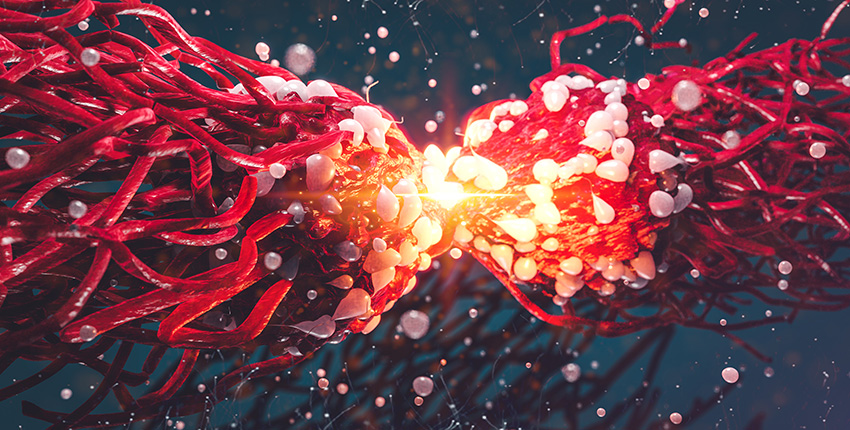
Image: CIPhotos/iStock/Getty Images Plus
Six Harvard Medical School postdoctoral researchers have received awards from the Damon Runyon Cancer Research Foundation.
Four of the HMS researchers are among six nationwide to receive a Damon Runyon-Dale F. Frey Award for Breakthrough Scientists. This award provides additional funding to scientists completing a Damon Runyon Fellowship Award and who have exceeded Damon Runyon’s highest expectations and are most likely to make paradigm-shifting advances that transform the way cancer is prevented, diagnosed and treated.
Two of the HMS researchers are among 16 to be named as new Damon Runyon Fellows. The Damon Runyon Fellowship Award encourages promising young scientists to pursue careers in cancer research by providing them with independent funding over four years to work on basic and translational cancer research projects in the laboratories of leading senior investigators.
The 2020 recipients of the Damon Runyon-Dale F. Frey Award for Breakthrough Scientists from HMS are:
Ivana Gasic, HMS research fellow in systems biology (Damon Runyon Merck Fellow 2016-2020)
Gasic is investigating the fundamental principles of tubulin autoregulation and the microtubule integrity response, a mechanism that detects and responds to changes in the microtubule cytoskeleton in interphase cells. Microtubules are frequent chemotherapy targets when treating various cancers such as leukemia, lymphomas, melanomas and lung, ovarian and breast cancers. Microtubule-targeting chemotherapeutics kill cancer cells by blocking cell division and inhibiting cell growth. Gasic’s work reveals how the microtubule-targeting drugs may work independently of cell cycle and suggests potential new pathways to specifically target cancer cells.
Natasha O’Brown, HMS research fellow in systems biology (Damon Runyon Fellow 2016-2020)
O’Brown is investigating the molecular mechanisms that govern the blood-brain barrier, the gatekeeper for the brain. While the blood-brain barrier protects the brain from pathogens and maintains the environment for normal brain function, it also acts as an obstacle to drug delivery for neurological diseases, including brain tumors. O’Brown has established the timeline of zebrafish blood-brain barrier functional development using reporter lines and tracer assays. She is using CRISPR technology to create mutants that will shed light on details of blood-brain barrier biology. A better understanding of the molecular determinants underlying blood-brain barrier properties may provide new therapeutic avenues for drug delivery.
Benjamin Stinson, HMS research fellow in biological chemistry and molecular pharmacology (Damon Runyon Fellow 2016-2020)
Stinson focuses on nonhomologous end joining (NHEJ), a cellular DNA repair process that repairs most DNA double-strand breaks (DSBs) in vertebrates. Failure to repair DSBs properly can lead to new mutations, which are a central feature of cancer initiation and progression. Stinson has discovered one way the NHEJ machinery modifies DNA at DSBs and minimizes errors when rejoining broken ends of the DNA molecule. He will further investigate the basic mechanisms of the two main DSB repair pathways, which are critical to understanding the causes of many cancers and informing therapeutic approaches.
Iva Tchasovnikarova, HMS research fellow in genetics at Massachusetts General Hospital (Damon Runyon Fellow 2016-2020)
Tchasovnikarova has developed an unbiased, broadly applicable method to identify cell-based reporters of any epigenetic process inside the nucleus. Epigenetic modifications do not change the DNA sequence but affect which genes are turned on or off, ensuring that only necessary proteins are produced. Disruption of epigenetic regulation, a hallmark of cancer, can result in malignant cellular transformation. Tchasovnikarova will utilize her novel technology to better understand the fundamental biology underlying these epigenetic mechanisms and identify optimal targets for novel therapies.
The November 2019 Damon Runyon Fellows from HMS are:
Erin Duffy, HMS research fellow in neurobiology, with her sponsor Michael Greenberg, the HMS Nathan Marsh Pusey Professor of Neurobiology, is investigating how neuronal activity can regulate gene expression through a potentially novel mechanism in the developing brain. Called RNA turnover, this mechanism may enable gene expression to be rapidly and locally controlled at individual connections between neurons based on neuronal activity. There is evidence that neuronal activity may contribute to pediatric malignant glioma brain tumors. Duffy aims to characterize this process and identify new therapeutic targets for pediatric brain cancer.
Nikit Patel, HMS research fellow in systems biology, with his sponsor Allon Klein, HMS associate professor of systems biology, is focusing on hematopoiesis, the process by which stem cells in the bone marrow differentiate into all the blood and immune cells in our bodies. Breakdown of this process is linked to cancers including myelomas and leukemias. Patel aims to determine critical components driving hematopoiesis by studying this process in different vertebrate animals and comparing evolutionarily conserved regulators. He will then use gene-editing methods to test whether these regulators play a role in mammalian hematopoiesis. This work has the potential to identify new therapeutic targets and novel strategies for combating blood-related cancers.
Adapted from a Damon Runyon Foundation news release.


